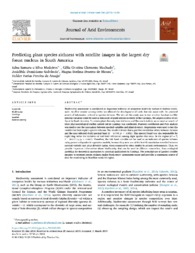Predicting plant species richness with satellite images in the largest dry forest nucleus in South America.
Predicting plant species richness with satellite images in the largest dry forest nucleus in South America.
Autoria: MEDEIROS, E. S. e S.; MACHADO, C. C. C.; GALVÍNCIO, J. D.; MOURA, M. S. B. de; ARAÚJO, H. F. P. de
Resumo: Biodiversity assessment is considered an important indicator of ecosystem health by various initiatives world-wide. Satellite remote sensing (SRS) has allowed the development of tools that can assist with the practicalsearch of information related to species richness. The aim of this study was to test whether Landsat satellitespectral variables could be used as indicators of plant species diversity in the Caatinga, the largest nucleus of dryforest in South America. To obtain plant diversity data (richness and Shannon's index), an exhaustive search ofplant phytosociological studies carried out in Caatinga was conducted. Pearson's correlation and PCA analysiswas used to test the association between spectral variables and plant diversity. Regressions were used to test themodels that best explain species richness. The results indicate that a positive correlation exists between richnessand the near-infrared (NIR) spectral band (r = 0.744; p < 0.001). This spectral band was also responsible forexplaining better the variation of leaf level reflectance among eight species that occur in the region (df = 7;F = 26317.55; p < 0.001). Therefore, the NIR band variable can be used as an indicator of species richnessusing power and quadratic regression models, because they were one of the bestfit association recorded betweenspectral variable and plant diversity index, when compared to other studies in natural environments. Thus, weprovide important information about biodiversity that can be used in different researches, from ecological modeling for theoretical approaches to practical applications in Caatinga. The potential use of Landsat satelliteimagery to estimate species richness makes biodiversity assessments easier and provides a continuous source ofdata for monitoring in Brazilian semiarid region
Ano de publicação: 2019
Tipo de publicação: Artigo de periódico
Unidade: Embrapa Semiárido
Palavras-chave: América do Sul, Biodiversidade, Caatinga, Floresta seca, Monitoramento, Plantas da Caatinga, Satélite, Sensoriamento Remoto
Observações
1 - Por padrão são exibidas publicações dos últimos 20 anos. Para encontrar publicações mais antigas, configure o filtro ano de publicação, colocando o ano a partir do qual você deseja encontrar publicações. O filtro está na coluna da esquerda na busca acima.
2 - Para ler algumas publicações da Embrapa (apenas as que estão em formato ePub), é necessário ter, no celular ou computador, um desses softwares gratuitos. Sistemas Android: Google Play Livros; IOS: iBooks; Windows e Linux: software Calibre.
Acesse outras publicações
Acesse a Base de Dados da Pesquisa Agropecuária (BDPA) para consultar o acervo completo das bibliotecas da Embrapa.

